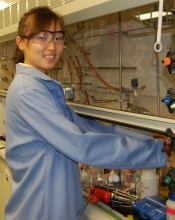
Major:
University:
Mentor(s):
Faculty Sponsor(s):
Faculty Sponsor's Department(s):
Project Title:
Project Description:
Lithium ion batteries are the most common commercially available batteries in spite of the volatility of the electrolyte and the safety issues associated with it. Therefore solid polymer electrolytes are considered to be the next generation of electrolyte used and poly(ethyleneoxide) is by far the most studied polymer as a polymeric electrolyte. Although these studies have shown that poly(ethyleneoxide) is a great ion-conductor at elevated temperature, its performance is still limited at lower temperatures. Recently, it was found that polyglycidyl ethers conduct ions orders of magnitude better at room temperature, yet improvement is necessary for commercial viability. In this study, we synthesized by anionic polymerization n-butyl-, isopropyl- and allylglycidyl ether monomers to afford their corresponding polymers. Instead of using the pure polymer, we made binary blends of both added salts and no salts. We determined miscibility of each mixture by optical clarity and glass transition temperature and investigated the effect of blending polymers on the conductivity. The mixture of poly(n-butylglycidylether) (PnBGE) and poly(allylglycidylether) (PAGE) exhibited no miscibility with or without salts within the temperature range of 20 to 80°C. Consequently, we have discovered that poly(isopropylglycidylether) (PiPGE) and PAGE become miscible above 50°C in presence of salts while the conductivity scales with the composition. Without salt, these polymers were not miscible. Finally, we further observed that mixtures of P(iPGE) and P(nBGE) are miscible at all temperatures and conductivity varied with different compositions of both polymers. Different characteristics of binary polymer blends suggest the promising applicability in the study of lithium polymer batteries.
